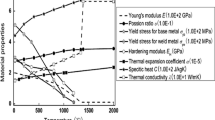Abstract
To control a heat source easily in the forming process of steel plate with heating, the electro-magnetic induction process has been used as a substitute of the flame heating process. However, only few studies have analyzed the deformation of a workpiece in the induction heating process by using a mathematical model. This is mainly due to the difficulty of modeling the heat flux from the inductor traveling on the conductive plate during the induction process. In this study, the heat flux distribution over a steel plate during the induction process is first analyzed by a numerical method with the assumption that the process is in a quasi-stationary state around the inductor and also that the heat flux itself greatly depends on the temperature of the workpiece. With the heat flux, heat flow and thermo-mechanical analyses on the plate to obtain deformations during the heating process are then performed with a commercial FEM program for 34 combinations of heating parameters. An artificial neural network is proposed to build a simplified relationship between deformations and heating parameters that can be easily utilized to predict deformations of steel plate with a wide range of heating parameters in the heating process. After its architecture is optimized, the artificial neural network is trained with the deformations obtained from the FEM analyses as outputs and the related heating parameters as inputs. The predicted outputs from the neural network are compared with those of the experiments and the numerical results. They are in good agreement.
Similar content being viewed by others
References
J. G. Shin, C. H. Ryu, J. H. Lee and W. D. Kim, A User-friendly, Advanced Line heating automation for accurate plate fabrication, J. of ship Production 19(1) (2003) 8–15.
H. Kawaguchi, M. Enokizono and T. Todaka, Thermal and magnetic field analysis of induction heating problem, J. of Materials Processing Technology 161 (2205) 193–198.
A. Boadi, Y. Tsuchida, T. Todaka and M. Enokizono, Designing of suitable construction of high-frequency induction heating coil by using finite-element method, IEEE Transactions on Magnetics 41(10) (2005) 4048–4050.
S. C. Chen, H. S. Peng, J. A. Chang and W. R. Jong, Simulations and verifications of induction heating on a mold plate, Int. Comm. Heat Mass Transfer 31(7) (2004) 971–980.
J. Nerg, Numerical solution of 2D and 3D induction heating problems with non-linear material properties taken into account, IEEE Transactions of Magnetics 36(5) 3119–3121.
V. Cingoski, A. Namera, K. Kaneda and H. Yamashita, Analysis of magneto-thermal coupled problem involving moving eddy-current conductions, IEEE Transactions of Magnetics 32(3) (1996) 1042–1045.
C.-D. Jang, H.-K. Kim and Y.-S Ha, Prediction of plate bending by high-frequency induction heating, J. of Ship Production 18(4) (2002) 226–236.
K.-Y. Bae, Y.-S. Yang, C.-M. Hyun and S.-H. Cho, Derivation of simplified formulas to predict deformations of plate in steel forming process with induction heating, Intl J. of Machine Tools & Manufacture 48 (2008) 1646–1652.
L. Fausett, Fundamentals of Neural Networks: Architectures, Algorithms, and Applications, Prentice Hall (1994).
K. Sadeghipour J.A. Dopkin and K. Li, A Computer Aided Finite Element- Experimental Analysis of Induction Heating Process of Steel, Computers in Industry 28 (1996) 195–205.
M. T. Hagan, H. B. Demuth and M. Beale, Neural Network Design, PWS Publishing Company (1996).
O. Fontenla-Romero, D. Erdogmus, J. C. Principe, A. Alonso-Betanzos and E. Castillo, Accelerating the convergence speed of neural networks learning methods using least squares, European Symposium on Artificial Neural Networks (2003).
N. N. R. Ranga Suri, Dipti Deodhare, P. Nagabhushan, Parallel Levenberg-Marquardt-based Neural Network Training on Linux clusters- A case study, 3rd Indian Conference on Computer Vision, Graphics and Image Processing, Ahmadabad (2002).
B. M. Wilamowski, S. Iplikci, O. Kaynak and M. Onder Efe, An algorithm for fast convergence in training neural networks,” IEEE (2001).
D. Nguyen and B. Widrow, Improving the learning speed of 2-layer Neural Networks by choosing initial values of the adaptive weights, Proc. of International Joint Conference on Neural Networks, San Diego (1990).
Author information
Authors and Affiliations
Corresponding author
Additional information
This paper was recommended for publication in revised form by Associate Editor Youngseog Lee
Truong-Thinh Nguyen received the B.S and M.S degrees from Ho Chi Minh city National University, Viet Nam, in 1997 and 2000, respectively. Now, he is a doctoral candidate in the Department of Mechanical Engineering at Chonnam National University, Korea. His research interests are Induction Heating, Thermal deformations, applications of Neural Network and Fuzzy logic in Industry, intelligent control.
Young-Soo Yang received a B.S. degree in Mechanical Engineering from Sungkyunkwan University in 1985. He then went on to receive his M.S. and Ph.D. degrees from KAIST in 1987 and 1991, respectively. Dr. Yang is currently a Professor at the School of Mechanical Engineering at Chonnam National University in Gwangju, Korea. He research interests are in the area of weld structure.
Kang-Yul Bae is a Professor of Mechatronics Engineering Department at Jinju National University in Jinju, Korea. He received a B.S. degree in Mechanical Engineering from Busan National University in 1984. He also holds the following degrees of M.S. in Production Engineering and Ph.D. in Mechanical Engineering from KAIST in 1986 and 1994, respectively. He has industrial experience from 1986 to 1998 at Hyundai Heavy Industries, Co. Ltd. as a senior researcher. His teaching and research areas include manufacturing processes, automation, and mechatronics.
Sung-Nam Choi received a B.S. and a M.S. degree in Department of Mechanical Engineering from Chonnam National University in 1989 and 1991. He then complete doctor course from the same University in 2006. He is currently a Senior Researcher at Non-Destructive Evaluation Center at Korea Electric Power Research Institute in Daejon, Korea. His research interests are in the area of weld integrity, fracture mechanics, and automated ultrasonic examination.
Rights and permissions
About this article
Cite this article
Nguyen, TT., Yang, YS., Bae, KY. et al. Prediction of deformations of steel plate by artificial neural network in forming process with induction heating. J Mech Sci Technol 23, 1211–1221 (2009). https://doi.org/10.1007/s12206-009-0101-5
Received:
Revised:
Accepted:
Published:
Issue Date:
DOI: https://doi.org/10.1007/s12206-009-0101-5




